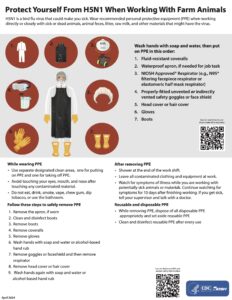Avian Influenza A(H5N1) Update: Risk to Public Remains Low
Public health officials in the United States are closely monitoring a current outbreak of avian influenza A(H5N1) virus, or “H5N1 bird flu”, that is impacting dairy cows in the U.S. CDC is working closely with USDA to monitor the current H5N1 bird flu situation in wild birds and poultry, dairy cows, and sporadic infections in other mammals, such as domesticated pets and wild animals. At this time, the risk to the general public from H5N1 bird flu is low. However, people who may be exposed to infected animals through occupational and/or recreational activities are recommended to take appropriate safety precautions.
Key takeaways from CDC’s situation update on April 19 include:
- USDA is now reporting that eight U.S. states have outbreaks in dairy cattle and that the virus has spread through cattle movement between herds and also from dairy cattle premises into nearby poultry premises and has infected a number of barn cats.
- Only one associated human case to date has been linked with this outbreak in dairy cows and was reported by Texas on April 1, 2024.
On April 23, the US FDA reported that “remnants” of bird flu virus have been found in pasteurized milk from infected dairy cows, but that the material is inactivated because of the pasteurization process and does not pose a risk to consumers. The FDA will continue to monitor the situation to ensure the safety of dairy products that could be impacted by this outbreak.
Extra Precautions for Farmworkers
The public health risk to the public remains low, but officials are emphasizing the importance of personal protective equipment for anyone who works with farm animals.
Click image to view infographic full size.
Preventing Pandemic Flu
In addition to tracking the current outbreak, scientists are researching prevention tools to stay ahead of the spread, including evaluating vaccines and antivirals that may help protect those at risk from H5N1.
Preparedness is incredibly important to preventing the next pandemic. The threat of flu virus spillover from animal populations into humans is one that public health officials take incredibly seriously.
Stay up to date with the latest response activities from the CDC here.
